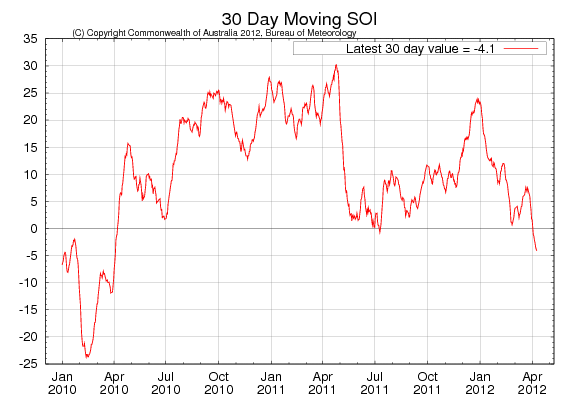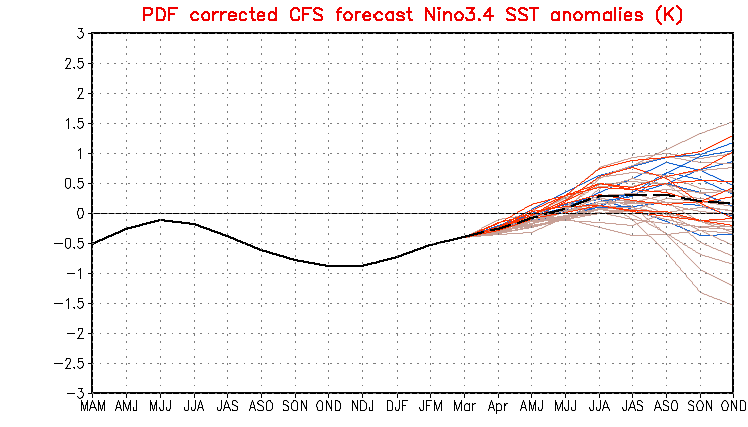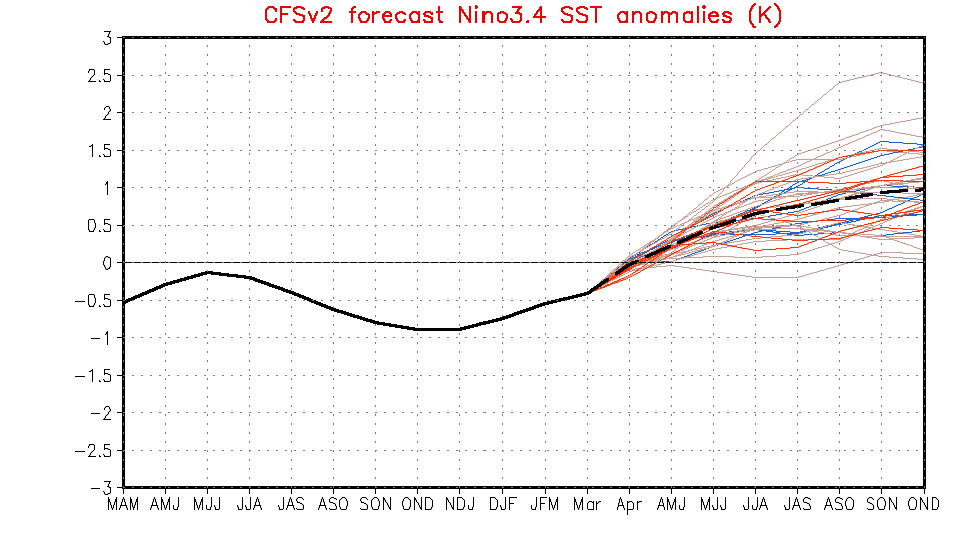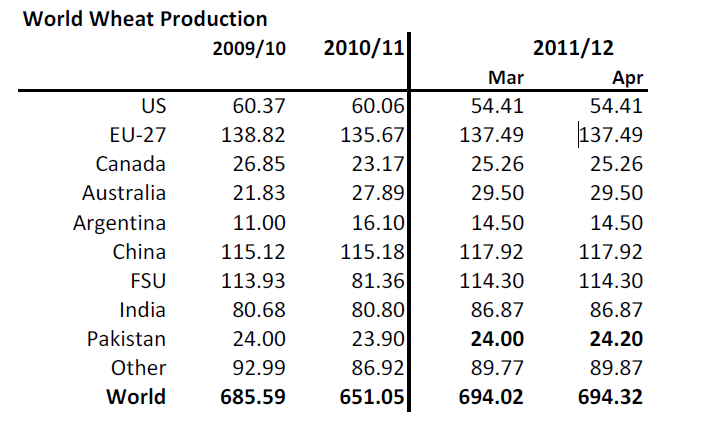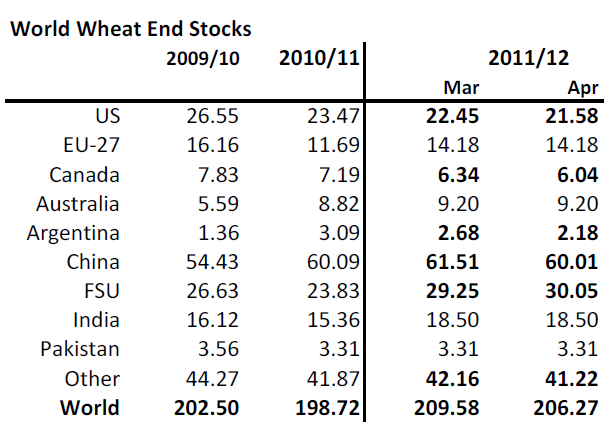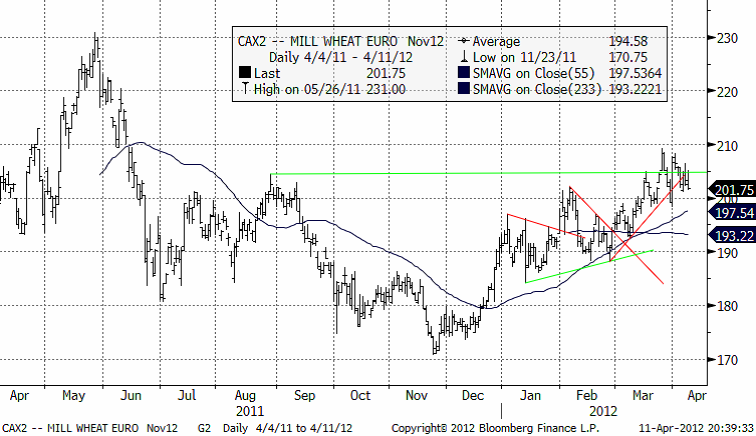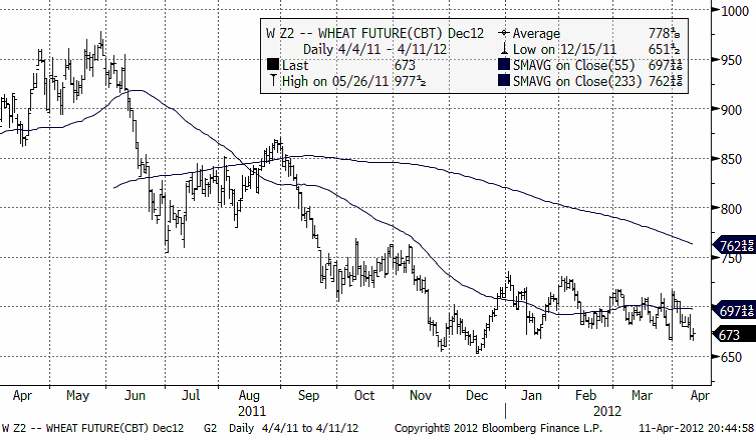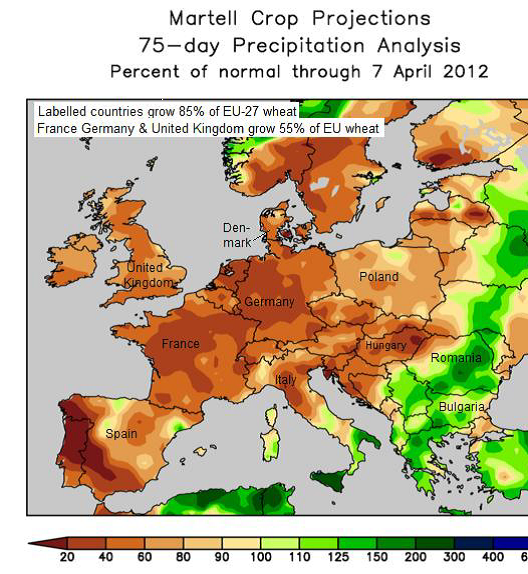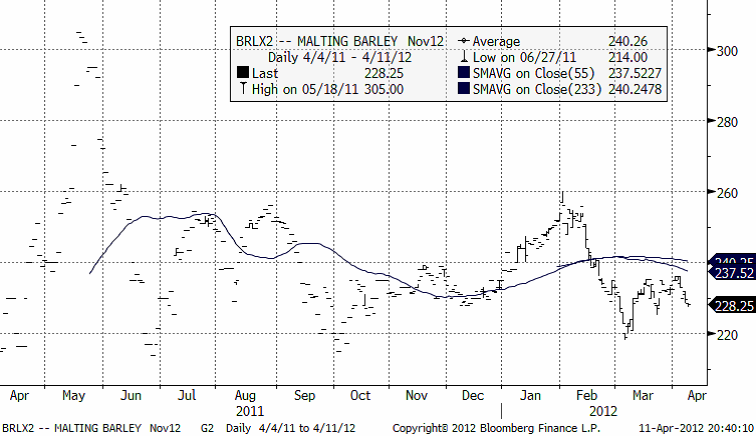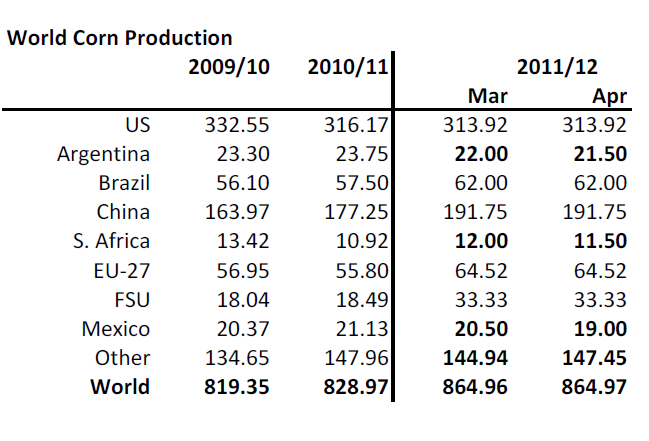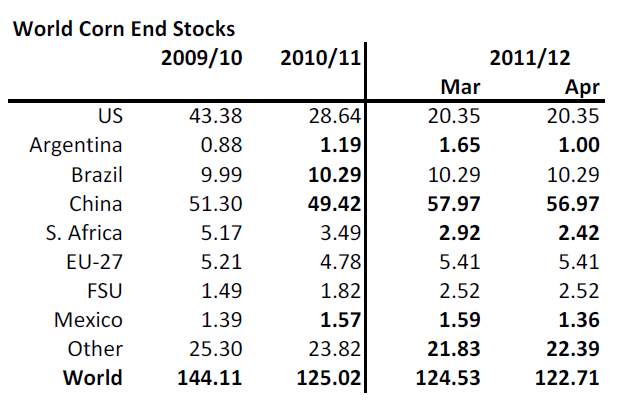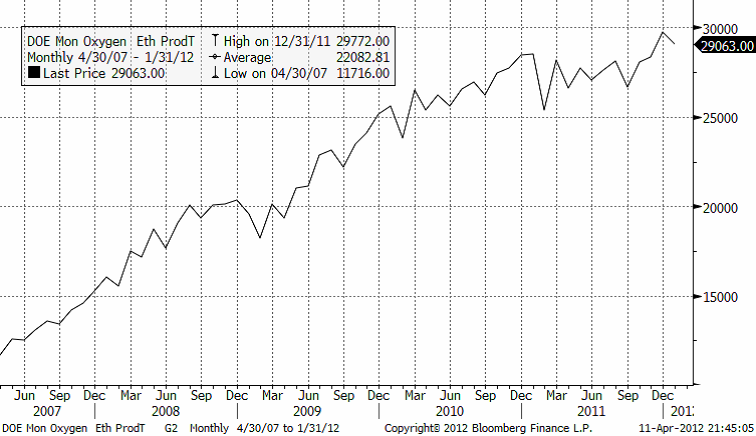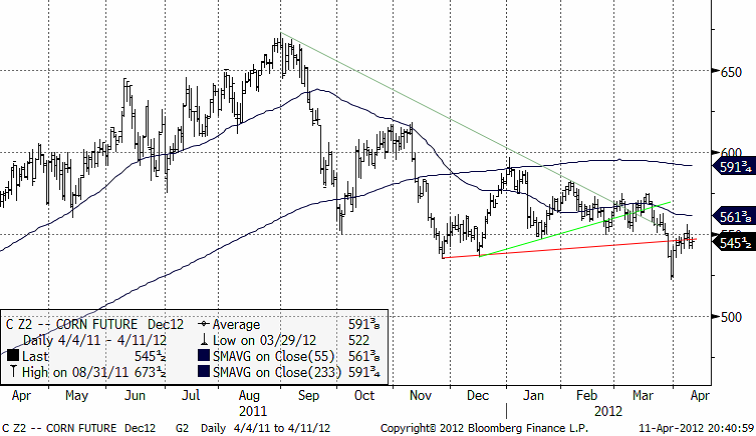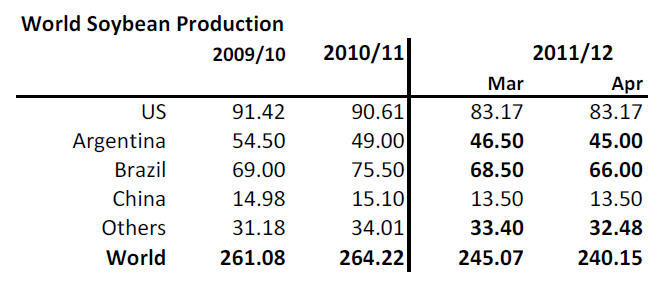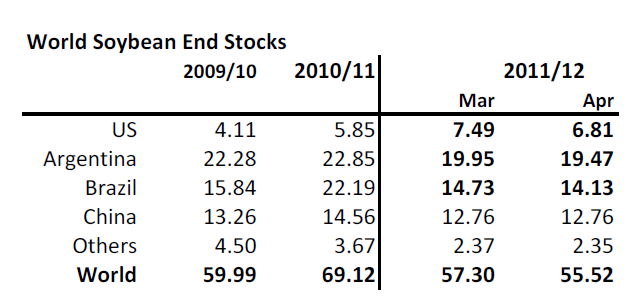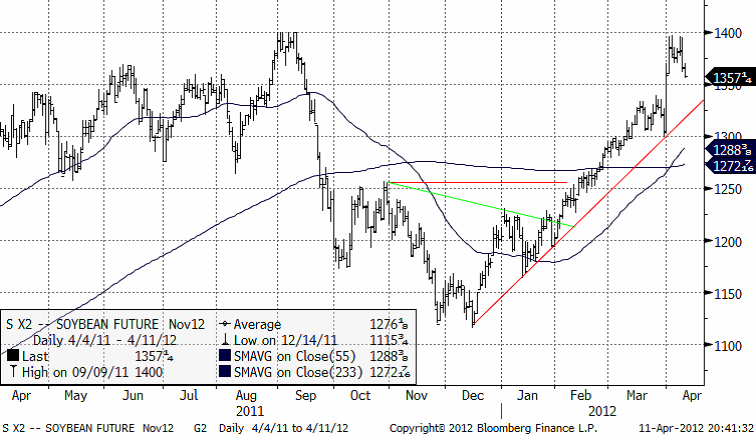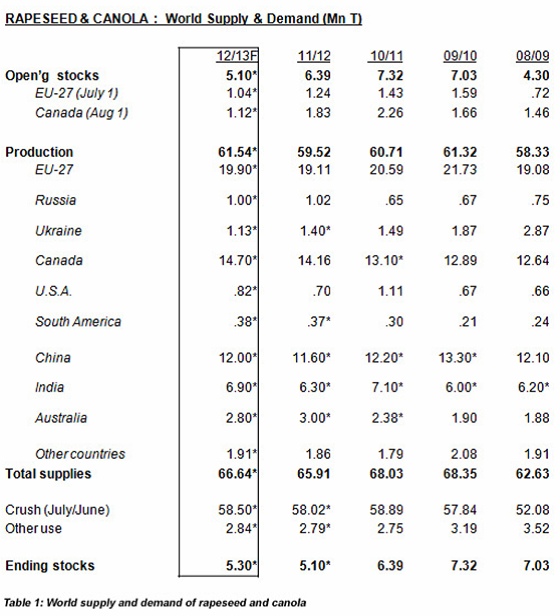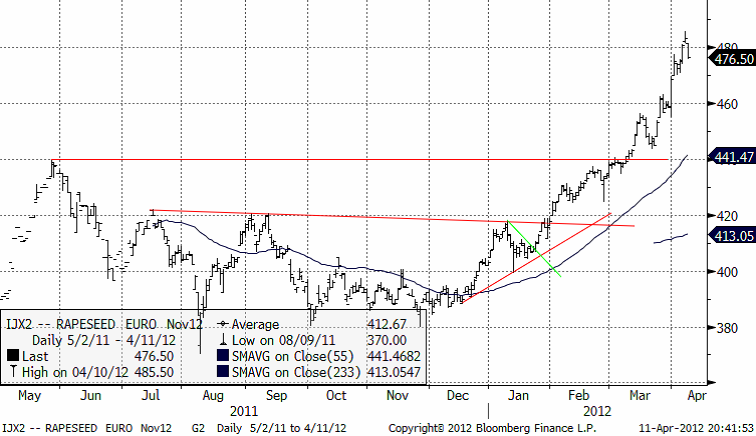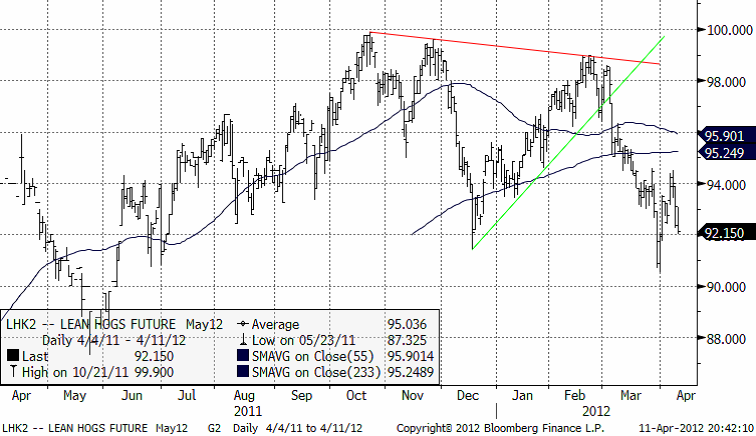Analys
SEB – Jordbruksprodukter, vecka 15 2012
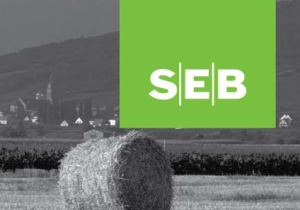 Vetepriset i USA har fallit med 5% sedan förra veckan. Bakom ligger flera faktorer, bland annat bättre väder. I omvärlden noterar vi en ny uppgång i räntorna i Spanien, en ny våg av misstro som vi inte sett sedan november förra året. Vi noterar att arbetsmarknaden i USA utvecklas svagt, enligt fredagens statistik.
Vetepriset i USA har fallit med 5% sedan förra veckan. Bakom ligger flera faktorer, bland annat bättre väder. I omvärlden noterar vi en ny uppgång i räntorna i Spanien, en ny våg av misstro som vi inte sett sedan november förra året. Vi noterar att arbetsmarknaden i USA utvecklas svagt, enligt fredagens statistik.
Sentimentet på aktiemarknaderna runt om i världen är rejält svagt. Kina, den stora motorn bakom råvaruboomen tycks hacka. Man kan tänka sig att sämre ekonomi i världen dämpar efterfrågan på mat. Den korrelationen är dock svag. Det viktigaste just nu tycker vi är utvecklingen av ENSO, som vi börjar brevet med.
Odlingsväder
Nedan ser vi Southern Oscillation Index, som mäter ENSO och indikerar La Niña om SOI > +8 och El Niño om SOI < -8. Vi ser att SOI minskat från +0.3 förra veckan till -4.1 i dagens rapport. Det är den lägsta nivån sedan mars för två år sedan. Prognoserna om ett möjligt El Niño och därmed vanligtvis följande superskörd ser ut att besanna
NOAA:s två senaste ensembleprognoser publicerades den 9 april den första är något högre, dvs något mer El Niño, medan den andra modellens prognoser ligger något lägre än de vi hade med i förra veckans veckobrev.
Nedan ser vi den andra modellen, CFS.v2, som också förutspår neutrala ENSO-förhållanden, men är kraftigare på El Niño-sidan för hösten.
Vete
Egypten, världens största importör av vete, har återigen köpt 115 000 ton av amerikanskt ursprung med leverans 21-31 maj enligt GASC.
[ Vinnande bud; USA; 55kt för 259.75$/t + frakt 24.00$/t från Alex Grain + 60kt för 259.75$/t + frakt 26.00$/t från Venus ]
WASDE-rapporten som publicerades av USDA i fredags visade inte på någon förändring alls vad gäller produktionsestimaten, som vi ser nedan.
Konsumtionen har justerats upp med 3 mt på global basis. Utgående lager sänks mest i Kina och i USA. Även Kanadas utgående lager sänks.
Det är väldigt små förändringar överlag. Rapporten ger ingen ny information att handla efter. Prisförändringarna blev också mycket små. Nedan ser vi novemberkontraktet på Matif. 210-nivån är ännu inte bruten, noterar vi.
Vi måste bara titta på Chicagokontraktet med ungefär samma löptid som Matifs novemberkontrakt. Decembervetet på CBOT har haft en helt annan prisutveckling de senaste månaderna än Matifkontraktet. När det har varit en prisuppgång på Matif har det varit ”sidledes” rörelse, till och med med en liten nedgång i USA.
Vän av ordning kanske då tänker på eurons svaga utveckling mot dollarn, men detta är inte hela förklaringen. I diagrammet nedan ser vi hur terminskurvorna för Chicagovete och Matifvete förändrat sig de senaste 7 handelsdagarna. Vi ser att Chicago fortsatt att falla, generellt. Matif har stigit, generellt. Som vanligt ser vi att augusti-kontraktet, detta illikvida kontrakt som snart ska försvinna, beter sig konstigt.
Utsikterna för den totala veteskörden i Europa ter sig dåliga just nu. Martell skriver den 9 april om torka, utvintring och dålig utveckling i östra Europa. Strategie Grains sänkte, som vi tidigare nämnt, estimaten för veteskörden i EU-27 förra månaden till 139.5 mt, vilket trots detta är 1.5% högre än förra året. Nedan ser vi nederbörden i förhållande till normalt för de senaste 75 dagarna i Europa.
Men vi måste komma ihåg att det troligtvis ser som sämst ut just nu. Med La Niña borta och kanske ett El Niño på väg att bildas kan vädret bli mycket bättre. Skörden i Europa har påverkats väldigt lite av vädret under januari till mars och mycket mer av vädret under maj, juni och juli. Utsikterna för detta ser mycket bättre ut.
Maltkorn
Novemberkontraktet på maltkorn ligger fortfarande under glidande medelvärden och det brukar tolkas negativt.
Potatis
Priset på industripotatis för leverans nästa år tog en paus efter förrförra veckans kraftiga prisuppgång. Priset har 15 euro som fixpunkt för den aktuella handeln.
Majs
Brasiliens produktion av majs för 2011/12 förväntas slå nytt rekord och Conab justerar upp sin prognos till 65.1 mt från 61.7 mt. Landet, som är världens tredje största producent av majs efter USA och Kina, producerade 57.4 mt majs under föregående skördeår.
Brasiliens skörd av majs (sommargröda) är nu till stor del avklarad och verkar bli något lägre till följd av det torra vädret, som också drabbat sojabönor. Däremot förväntas det gynnsamma vädret i centrala och västra delar av landet, som t.ex Mato Grosso, ge lantbrukare chansen att få ut det mesta möjliga av sin rekordstora sådd av majs som vintergröda (safrinha).
USDA verkar inte ha hängt med i svängarna här. De gjorde ingen justering av väntad produktion i Brasilien utan ligger kvar på 62 mt, 3mt under Conab. Vi tror mer på Conab. Allt annat lika borde det kunna innebära att global skörd, i USDA:s termer, är större, än vad man trodde förra månaden.
Konsumtionen i Kina justeras upp 1 mt av USDA. Bakom det ligger ett justerande av ingående lager, konsumtion och utgående lager, men i princip är innebörden att konsumtionen väntas öka med 1 mt.
USDA justerar ner etanolproduktionen i USA. Kritik mot detta har riktats mot USDA. Kritiken har menat att etanolproduktionen inte alls minskat i USA, men tillgänglig statistik stödjer USDA:s beslut.
Nedan ser vi etanolproduktionen per månad i 1000 fat i USA, enligt Department of Energys rapport. Den stora tillväxten i produktionen ligger bakom oss och hittills i år ser vi en nedgång i produktionen.
Prisreaktionen i decemberkontraktet på CBOT var en prisnedgång, som vi ser i nedanstående kursdiagram.
Vi går igång, trots allt, på den tekniska bilden. Rekylen upp mot 550 cent ser riktigt ”bearish” ut. Lite bättre väder i USA, lite lägre siffror i Southern Oscillation Index, och priset kan få en ordentlig skjuts nedåt.
Sojabönor
Brasilianska Conab publicerade en ny prognos för skördeåret 2011/12 igår. Skördeåret startade den 1 september och merparten redan har skördats. Conab justerade ner skördeprognosen till 65.6 mt från den tidigare uppskattningen på 68.7 mt som publicerades för en månad sedan och från 75.3 mt under föregående skördeår. Detta trots en ökning av areal med 3,4% till rekordhöga 25 miljoner hektar.
Odlare av sojabönor i Brasilien, världens näst största producent efter USA, kommer enligt Conab att skörda mindre än vad tidigare prognoser har visat efter att det torra vädret som associeras med La Nina har skadat grödor i landets södra delar, framförallt i regionerna Rio Grande do Sul och Parana där de största bortfallen väntas med 44 respektive 36 procent.
Torka har plågat flera av de södra sojabönsproducerande regionerna i Brasilien, Argentina och Paraguay, som tillsammans står för mer än hälften av världens handel med sojabönor. WASDE-rapporten från USDA justerade också ner skörden, med 2.5 mt och landar på ungefär samma siffra som Conab, 66 mt. Skörden i Argentina justeras också ner och tillsammans är de den största anledningen till att global produktion sänks med 5 mt i denna april månads rapport.
Konsumtionen i Sydamerika sänks med 2 mt vilket bidrar till att globala utgående lager bara sänks med drygt 2 mt.
Det var en klart ”bullish” rapport, men marknaden har valt att ta fasta på den negativa statistiken för global ekonomi (efterfrågesidan) som kom samtidigt och fick aktiemarknaderna att falla runtom i världen. Nederbörd i USA tycks också ge vatten på kvarnen för dem som pekat på att ett El Niño kan vara i antågande.
Tekniskt noterar vi att prisuppgången vände precis på 1400 cent, som lockade fram säljarna även vid toppen i september förra året.
Raps
Även om kanadensiska lantbrukare uppnår en rekordskörd av canola på 14.5-15 mt i slutet av sommaren 2012, är det stor sannolikhet att den globala produktionen av raps och canola inte kommer att kunna möte efterfrågan under 2012/13 – framförallt pga av dåliga utsikter för höstgrödorna i EU och Ukraina.
Oil World uppskattar en ökning av arealen för kanadensisk canola med 3-4% till en ny högsta nivå på 7.9 miljoner hektar (jämfört med 7.6 miljoner hektar i fjol). Canola har haft en fenomenal utveckling i Kanada och arealen har i stort sett fördubblats under en 10-årsperiod från 3.9 miljoner hektar under våren 2002. Som en följd av detta har dock produktionen av spannmål, framförallt korn och vete, minskat kraftigt.
Enligt preliminära prognoser kommer den globala produktionen av raps och canola att uppgå till 61.5 mt, vilket motsvarar en måttlig återhämtning på 2 mt från nuvarande säsong. Detta under förutsättningen gynnsamma väderförhållanden och ökad sådd i Kanada och Indien.
Nedan ser vi kursdiagrammet för novemberkontraktet, som gick upp över 480 euro per ton innan priset föll tillbaka och stängde på 476.5 euro igår, onsdag.
440 euro utgör nu, när den nivån är bruten, ett tekniskt stöd. Vi fortsätter därför att ha en neutral vy, om inte 440-nivån bryts igen.
Gris
Majkontraktet som steg till över 94 cent har nu fallit ner mot 92 cent, en stödnivå igen. Svagare ekonomisk statistik väcker oro för efterfrågan.
[box]SEB Veckobrev Jordbruksprodukter är producerat av SEB Merchant Banking och publiceras i samarbete och med tillstånd på Råvarumarknaden.se[/box]
Disclaimer
The information in this document has been compiled by SEB Merchant Banking, a division within Skandinaviska Enskilda Banken AB (publ) (“SEB”).
Opinions contained in this report represent the bank’s present opinion only and are subject to change without notice. All information contained in this report has been compiled in good faith from sources believed to be reliable. However, no representation or warranty, expressed or implied, is made with respect to the completeness or accuracy of its contents and the information is not to be relied upon as authoritative. Anyone considering taking actions based upon the content of this document is urged to base his or her investment decisions upon such investigations as he or she deems necessary. This document is being provided as information only, and no specific actions are being solicited as a result of it; to the extent permitted by law, no liability whatsoever is accepted for any direct or consequential loss arising from use of this document or its contents.
About SEB
SEB is a public company incorporated in Stockholm, Sweden, with limited liability. It is a participant at major Nordic and other European Regulated Markets and Multilateral Trading Facilities (as well as some non-European equivalent markets) for trading in financial instruments, such as markets operated by NASDAQ OMX, NYSE Euronext, London Stock Exchange, Deutsche Börse, Swiss Exchanges, Turquoise and Chi-X. SEB is authorized and regulated by Finansinspektionen in Sweden; it is authorized and subject to limited regulation by the Financial Services Authority for the conduct of designated investment business in the UK, and is subject to the provisions of relevant regulators in all other jurisdictions where SEB conducts operations. SEB Merchant Banking. All rights reserved.
Analys
Brent crude ticks higher on tension, but market structure stays soft

Brent crude has climbed roughly USD 1.5-2 per barrel since Friday, yet falling USD 0.3 per barrel this mornig and currently trading near USD 67.25/bbl after yesterday’s climb. While the rally reflects short-term geopolitical tension, price action has been choppy, and crude remains locked in a broader range – caught between supply-side pressure and spot resilience.

Prices have been supported by renewed Ukrainian drone strikes targeting Russian infrastructure. Over the weekend, falling debris triggered a fire at the 20mtpa Kirishi refinery, following last week’s attack on the key Primorsk terminal.
Argus estimates that these attacks have halted ish 300 kbl/d of Russian refining capacity in August and September. While the market impact is limited for now, the action signals Kyiv’s growing willingness to disrupt oil flows – supporting a soft geopolitical floor under prices.
The political environment is shifting: the EU is reportedly considering sanctions on Indian and Chinese firms facilitating Russian crude flows, while the U.S. has so far held back – despite Bessent warning that any action from Washington depends on broader European participation. Senator Graham has also publicly criticized NATO members like Slovakia and Hungary for continuing Russian oil imports.
It’s worth noting that China and India remain the two largest buyers of Russian barrels since the invasion of Ukraine. While New Delhi has been hit with 50% secondary tariffs, Beijing has been spared so far.
Still, the broader supply/demand balance leans bearish. Futures markets reflect this: Brent’s prompt spread (gauge of near-term tightness) has narrowed to the current USD 0.42/bl, down from USD 0.96/bl two months ago, pointing to weakening backwardation.
This aligns with expectations for a record surplus in 2026, largely driven by the faster-than-anticipated return of OPEC+ barrels to market. OPEC+ is gathering in Vienna this week to begin revising member production capacity estimates – setting the stage for new output baselines from 2027. The group aims to agree on how to define “maximum sustainable capacity,” with a proposal expected by year-end.
While the IEA pegs OPEC+ capacity at 47.9 million barrels per day, actual output in August was only 42.4 million barrels per day. Disagreements over data and quota fairness (especially from Iraq and Nigeria) have already delayed this process. Angola even quit the group last year after being assigned a lower target than expected. It also remains unclear whether Russia and Iraq can regain earlier output levels due to infrastructure constraints.
Also, macro remains another key driver this week. A 25bp Fed rate cut is widely expected tomorrow (Wednesday), and commodities in general could benefit a potential cut.
Summing up: Brent crude continues to drift sideways, finding near-term support from geopolitics and refining strength. But with surplus building and market structure softening, the upside may remain capped.
Analys
Volatile but going nowhere. Brent crude circles USD 66 as market weighs surplus vs risk

Brent crude is essentially flat on the week, but after a volatile ride. Prices started Monday near USD 65.5/bl, climbed steadily to a mid-week high of USD 67.8/bl on Wednesday evening, before falling sharply – losing about USD 2/bl during Thursday’s session.

Brent is currently trading around USD 65.8/bl, right back where it began. The volatility reflects the market’s ongoing struggle to balance growing surplus risks against persistent geopolitical uncertainty and resilient refined product margins. Thursday’s slide snapped a three-day rally and came largely in response to a string of bearish signals, most notably from the IEA’s updated short-term outlook.
The IEA now projects record global oversupply in 2026, reinforcing concerns flagged earlier by the U.S. EIA, which already sees inventories building this quarter. The forecast comes just days after OPEC+ confirmed it will continue returning idle barrels to the market in October – albeit at a slower pace of +137,000 bl/d. While modest, the move underscores a steady push to reclaim market share and adds to supply-side pressure into year-end.
Thursday’s price drop also followed geopolitical incidences: Israeli airstrikes reportedly targeted Hamas leadership in Doha, while Russian drones crossed into Polish airspace – events that initially sent crude higher as traders covered short positions.
Yet, sentiment remains broadly cautious. Strong refining margins and low inventories at key pricing hubs like Europe continue to support the downside. Chinese stockpiling of discounted Russian barrels and tightness in refined product markets – especially diesel – are also lending support.
On the demand side, the IEA revised up its 2025 global demand growth forecast by 60,000 bl/d to 740,000 bl/d YoY, while leaving 2026 unchanged at 698,000 bl/d. Interestingly, the agency also signaled that its next long-term report could show global oil demand rising through 2050.
Meanwhile, OPEC offered a contrasting view in its latest Monthly Oil Market Report, maintaining expectations for a supply deficit both this year and next, even as its members raise output. The group kept its demand growth estimates for 2025 and 2026 unchanged at 1.29 million bl/d and 1.38 million bl/d, respectively.
We continue to watch whether the bearish supply outlook will outweigh geopolitical risk, and if Brent can continue to find support above USD 65/bl – a level increasingly seen as a soft floor for OPEC+ policy.
Analys
Waiting for the surplus while we worry about Israel and Qatar

Brent crude makes some gains as Israel’s attack on Hamas in Qatar rattles markets. Brent crude spiked to a high of USD 67.38/b yesterday as Israel made a strike on Hamas in Qatar. But it wasn’t able to hold on to that level and only closed up 0.6% in the end at USD 66.39/b. This morning it is starting on the up with a gain of 0.9% at USD 67/b. Still rattled by Israel’s attack on Hamas in Qatar yesterday. Brent is getting some help on the margin this morning with Asian equities higher and copper gaining half a percent. But the dark cloud of surplus ahead is nonetheless hanging over the market with Brent trading two dollar lower than last Tuesday.

Geopolitical risk premiums in oil rarely lasts long unless actual supply disruption kicks in. While Israel’s attack on Hamas in Qatar is shocking, the geopolitical risk lifting crude oil yesterday and this morning is unlikely to last very long as such geopolitical risk premiums usually do not last long unless real disruption kicks in.
US API data yesterday indicated a US crude and product stock build last week of 3.1 mb. The US API last evening released partial US oil inventory data indicating that US crude stocks rose 1.3 mb and middle distillates rose 1.5 mb while gasoline rose 0.3 mb. In total a bit more than 3 mb increase. US crude and product stocks usually rise around 1 mb per week this time of year. So US commercial crude and product stock rose 2 mb over the past week adjusted for the seasonal norm. Official and complete data are due today at 16:30.
A 2 mb/week seasonally adj. US stock build implies a 1 – 1.4 mb/d global surplus if it is persistent. Assume that if the global oil market is running a surplus then some 20% to 30% of that surplus ends up in US commercial inventories. A 2 mb seasonally adjusted inventory build equals 286 kb/d. Divide by 0.2 to 0.3 and we get an implied global surplus of 950 kb/d to 1430 kb/d. A 2 mb/week seasonally adjusted build in US oil inventories is close to noise unless it is a persistent pattern every week.
US IEA STEO oil report: Robust surplus ahead and Brent averaging USD 51/b in 2026. The US EIA yesterday released its monthly STEO oil report. It projected a large and persistent surplus ahead. It estimates a global surplus of 2.2 m/d from September to December this year. A 2.4 mb/d surplus in Q1-26 and an average surplus for 2026 of 1.6 mb/d resulting in an average Brent crude oil price of USD 51/b next year. And that includes an assumption where OPEC crude oil production only averages 27.8 mb/d in 2026 versus 27.0 mb/d in 2024 and 28.6 mb/d in August.
Brent will feel the bear-pressure once US/OECD stocks starts visible build. In the meanwhile the oil market sits waiting for this projected surplus to materialize in US and OECD inventories. Once they visibly starts to build on a consistent basis, then Brent crude will likely quickly lose altitude. And unless some unforeseen supply disruption kicks in, it is bound to happen.
US IEA STEO September report. In total not much different than it was in January
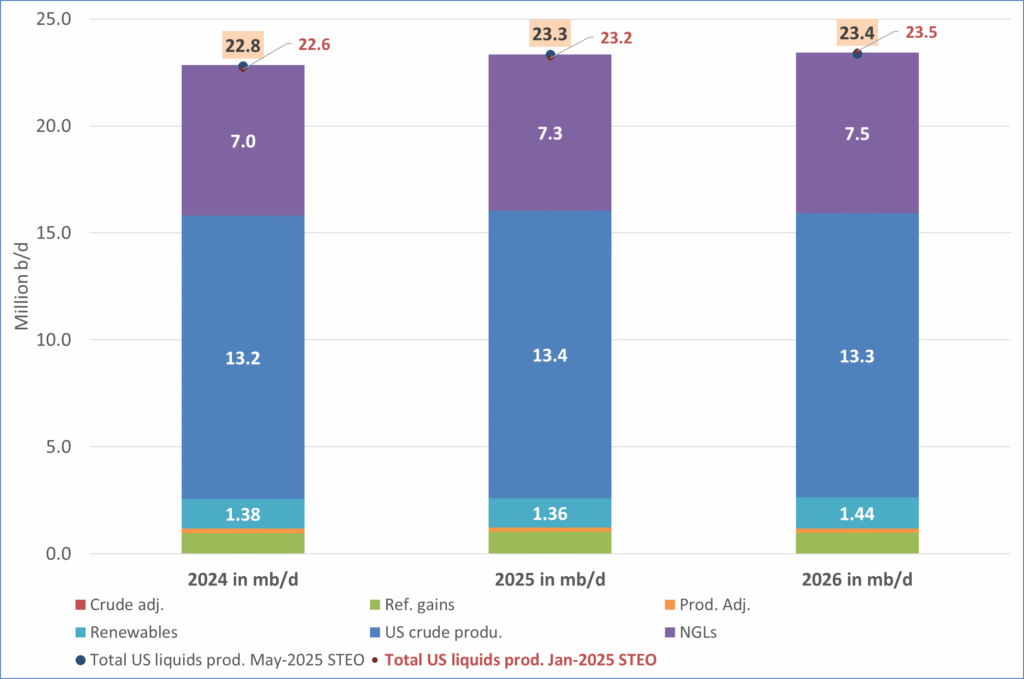
US IEA STEO September report. US crude oil production contracting in 2026, but NGLs still growing. Close to zero net liquids growth in total.
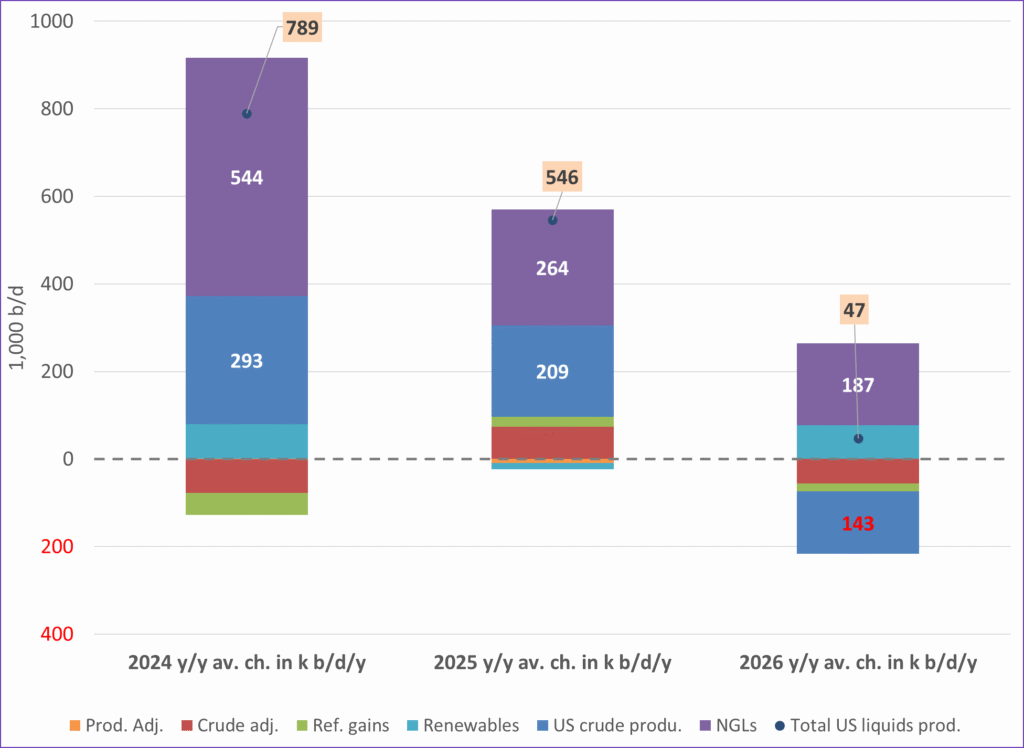
-

 Nyheter4 veckor sedan
Nyheter4 veckor sedanMeta bygger ett AI-datacenter på 5 GW och 2,25 GW gaskraftverk
-
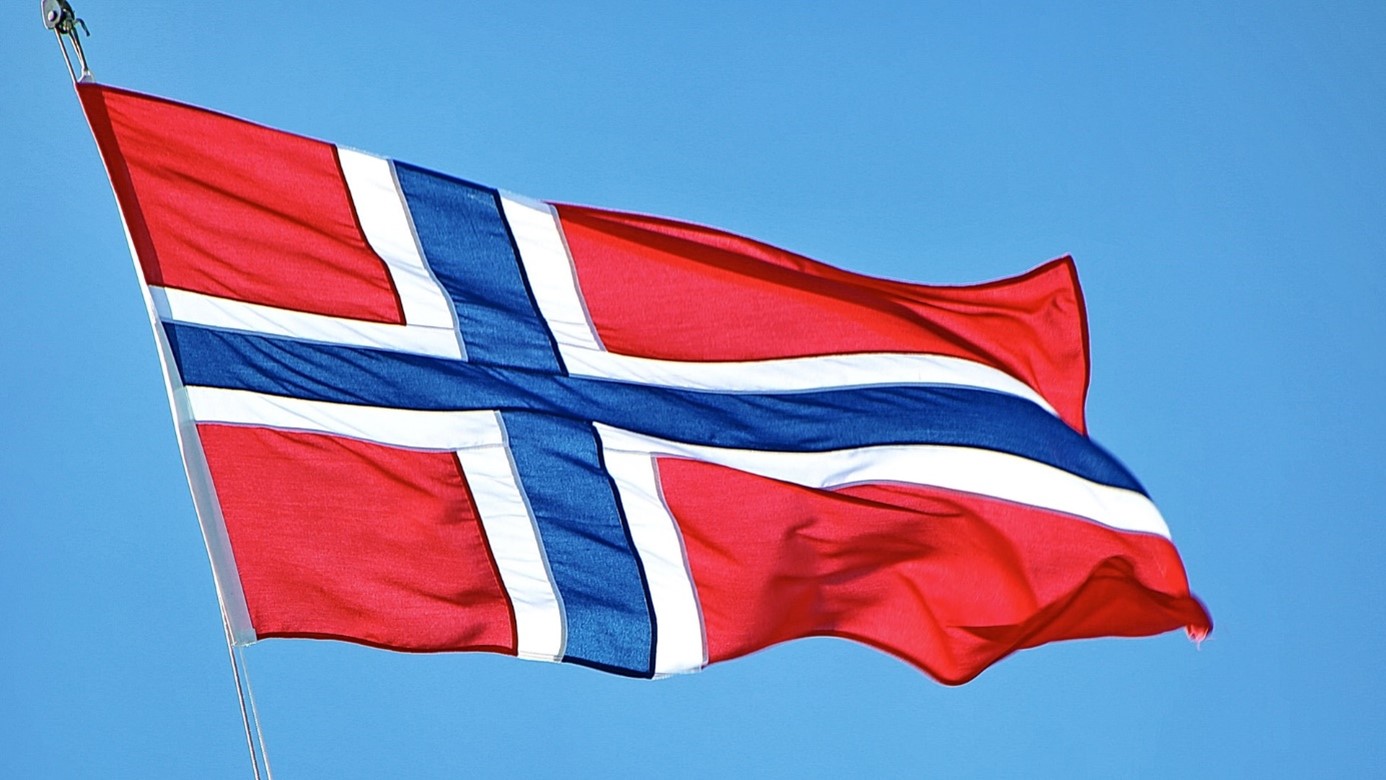
 Nyheter4 veckor sedan
Nyheter4 veckor sedanAker BP gör ett av Norges största oljefynd på ett decennium, stärker resurserna i Yggdrasilområdet
-

 Analys4 veckor sedan
Analys4 veckor sedanBrent sideways on sanctions and peace talks
-

 Nyheter4 veckor sedan
Nyheter4 veckor sedanEtt samtal om koppar, kaffe och spannmål
-

 Nyheter4 veckor sedan
Nyheter4 veckor sedanSommarens torka kan ge högre elpriser i höst
-

 Analys4 veckor sedan
Analys4 veckor sedanBrent edges higher as India–Russia oil trade draws U.S. ire and Powell takes the stage at Jackson Hole
-

 Nyheter3 veckor sedan
Nyheter3 veckor sedanMahvie Minerals är verksamt i guldrikt område i Finland
-

 Analys3 veckor sedan
Analys3 veckor sedanIncreasing risk that OPEC+ will unwind the last 1.65 mb/d of cuts when they meet on 7 September


